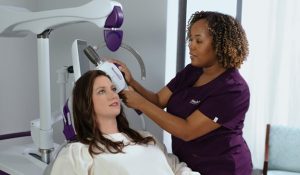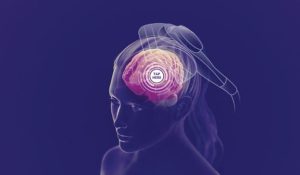
What Is TMS?
Transcranial Magnetic Stimulation (TMS) is a treatment for Major Depressive Disorder (MDD) in adults who have failed to receive satisfactory improvement from antidepressant medication.
It is a non-invasive, outpatient procedure which uses a pulsed magnetic field to stimulate function in brain regions known to affect mood. Patients remain awake and alert throughout treatment, which is provided in the comfort and safety of a psychiatrist’s office. It is not a drug, “shock” therapy, or surgery. It is a safe, effective treatment for MDD without the common side effects of medication.
Since the 1980s, TMS has been used to study the nerve fibers that carry information about movements from the brain to the spinal cord and onto the muscles. In the late 1990s, physicians began to explore the therapeutic potential of transcranial magnetic stimulation for the treatment of a variety of diseases, with depression being the most thoroughly studied to-date. Since then, numerous trials have been conducted to investigate the safety and efficacy of TMS as a treatment for depression, with the two largest randomized trials being conducted with the NeuroStar® Advanced Therapy System.
What is NeuroStar® Advanced Therapy?
The NeuroStar System is the fastest TMS device cleared by the FDA for the treatment of depression. NeuroStar Advanced Therapy is available by prescription only. It is not for everyone with depression, so patients should consult a NeuroStar doctor to determine eligibility. For complete prescribing and safety information, please visit www.NeuroStar.com.
How does TMS work?
During TMS, the treating clinician positions the treatment coil over the left prefrontal cortex, an area of the brain known to affect mood. Through the treatment coil, the NeuroStar System generates a highly focused, pulsed magnetic field, similar in type and strength to those produced by a magnetic resonance imaging (MRI) machine, to stimulate cortical neurons.
TMS Process
 Pulsed magnetic fields induce small electric currents in the prefrontal cortex of the brain.
Pulsed magnetic fields induce small electric currents in the prefrontal cortex of the brain.- Local neurons depolarize and release neurotransmitters.
- Distant areas of the limbic system are activated via neuronal pathways.
- Blood flow and glucose metabolism rise in the stimulated regions, which is thought to result in improved mood.
Repeated activation of the left prefrontal cortex is shown to produce antidepressant effects in patients suffering from major depression. NeuroStar provides targeted stimulation of the brain regions involved in mood regulation without the burden of systemic side effects.
How Soon Do You See Results?
Many patients start to see improvement within 2 to 3 weeks of treatment. This can include changes in mood, fewer days of depression, and increased desire to engage with other people more often.
Who is Eligible for TMS?
- Adults 18 years of age and older who are diagnosed with moderate to severe Major Depressive Disorder (MDD)
- Depression symptoms have not been relieved by at least two antidepressant medications (some insurance companies require up to four failed medications)
- No foreign metal in or near the head or metallic/magnetic implants (most dental work is safe)
- Not pregnant or nursing
Learn More
If you or someone you know is interested in learning more about TMS, contact St. Luke’s Penn Foundation’s Sacred Heart office at 610-776-4838.
Read our blog article
TMS Could Help Rewire Your Brain for Better Mental Health
to learn more about how TMS works, who it’s for, and why it could be a game-changer in mental health care.
Listen as Dr. James James, Chair of Psychiatry, talks about the evolution of depression on the Just STARt the Conversation podcast.
 Pulsed magnetic fields induce small electric currents in the prefrontal cortex of the brain.
Pulsed magnetic fields induce small electric currents in the prefrontal cortex of the brain.